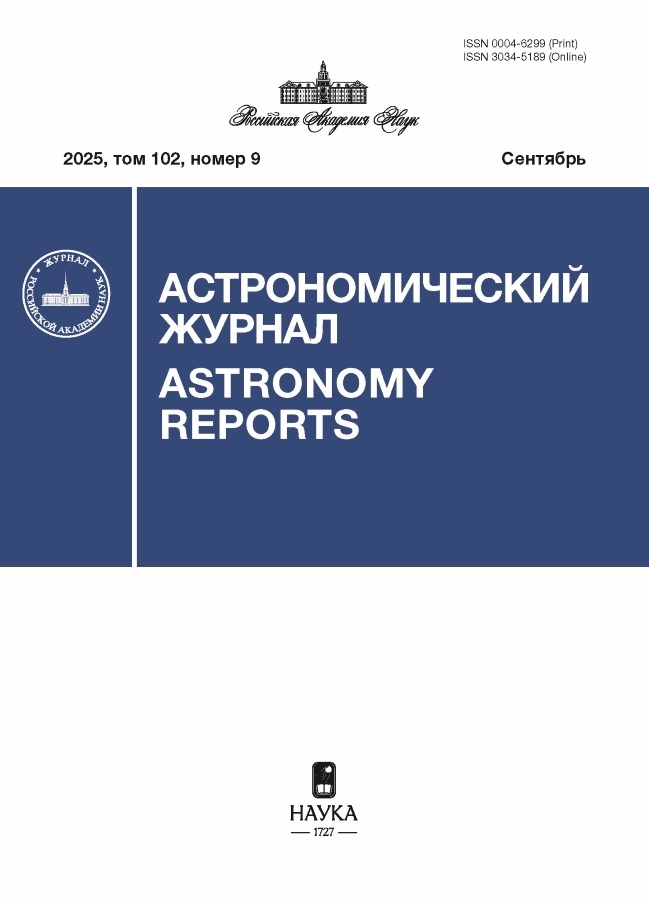Modeling the thermal structure of a protoplanetary disk using multiband flux-limited diffusion approximation
- Authors: Pavlyuchenkov Y.N.1, Akimkin V.V.1
-
Affiliations:
- Institute of Astronomy of the Russian Academy of Sciences
- Issue: Vol 102, No 9 (2025)
- Pages: 745-762
- Section: Articles
- URL: https://rjmseer.com/0004-6299/article/view/695909
- DOI: https://doi.org/10.31857/S0004629925090012
- ID: 695909
Cite item
Abstract
This work continues the analysis of the model for calculating the thermal structure of an axisymmetric protoplanetary disk, initiated in the paper by Pavlyuchenkov (2024). The model is based on the well-known Flux-Limited Diffusion (FLD) approximation with separate calculation of heating by direct stellar radiation (hereinafter referred to as the FLDs method). In addition to the previously described FLDs model with wavelength-averaged opacities, we present a multiband model mFLDs, where the spectrum of thermal radiation is divided into several frequency bands. The model is based on an implicit finite-difference scheme for the equations of thermal radiation diffusion, which reduces to a system of linear algebraic equations written in hypermatrix form. A modified Gauss method for inverting the sparse hypermatrix of the original system of linear equations is proposed. The simulation results described in the article show that the midplane radial temperature profile obtained with the mFLDs method has a variable slope in accordance with the reference Monte Carlo radiative transfer simulations. The mFLDs model also qualitatively reproduces the non-isothermality of the temperature distribution along the angular coordinate near the midplane, which is not provided by the FLDs method. However, quantitative differences remain between the reference temperature values and the results of mFLDs. These differences are likely due to the diffusive nature of the FLD approximation. It is also shown that the characteristic times for the disk to reach thermal equilibrium within the mFLDs model can be significantly shorter than in FLDs. This property should be taken into account when modeling non-stationary processes in protoplanetary disks within FLD-based models.
Keywords
About the authors
Ya. N. Pavlyuchenkov
Institute of Astronomy of the Russian Academy of Sciences
Email: pavyar@inasan.ru
Moscow, Russia
V. V. Akimkin
Institute of Astronomy of the Russian Academy of SciencesMoscow, Russia
References
- Y.N. Pavlyuchenkov, Astron. Rep. 68(11), 1045 (2024).
- P.J. Armitage, arXiv:1509.06382 [astro-ph.SR] (2015).
- G. Lesur, M. Flock, B. Ercolano, M. Lin, et al., in Protostars and Planets VII, Proc. of a Conference held 10–15 April 2023 at Kyoto, Japan; edited by S. Inutsuka, Y. Aikawa, T. Muto, K. Tomida, and M. Tamura (2023) (San Francisco, 2023), ASP Conf. Ser. 534, p. 465.
- R. Teyssier and B. Commerçon, Frontiers in Astron. and Space Sci. 6, id. 51 (2019), arXiv:1907.08542 [astro-ph.IM].
- R. Wünsch, Frontiers in Astron. and Space Sci. 11, id. 1346812 (2024), arXiv:2403.05410 [astro-ph.IM].
- C.D. Levermore and G.C. Pomraning, 248, 321 (1981).
- Y.N. Pavlyuchenkov, D.S. Wiebe, V.V. Akimkin, M.S. Khramtsova, and T. Henning, Monthly Not. Roy. Astron. Soc. 421(3), 2430 (2012), arXiv:1201.0642 [astro-ph.GA].
- C.P. Dullemond, G. J. van Zadelhoff, A. Natta, Astron. Astrophys. 389, 464 (2002); arXiv: astro-ph/0204281.
- B. van der Holst, G. Tóth, I.V. Sokolov, K.G. Powell, et al., Supp. 194(2), id. 23 (2011), arXiv:1101.3758 [astro-ph.SR].
- N. Vaytet, E. Audit, G. Chabrier, B. Commercon, and J. Masson, Astron. and Astrophys. 543, id. A60 (2012), arXiv:1205.5143 [astro-ph.SR].
- D. Mihalas, Stellar atmospheres (San Francisco: W.H. Freeman, 1978).
- C.P. Dullemond, A. Juhasz, A. Pohl, F. Sereshti, R. Shetty, T. Peters, B. Commercon, and M. Flock, RADMC-3D: A multi-purpose radiative transfer tool, Astrophysics Source Code Library, record ascl:1202.015 (2012).
Supplementary files










